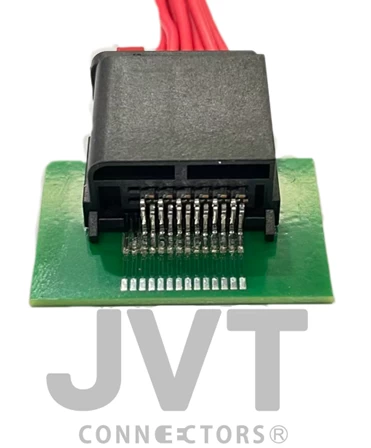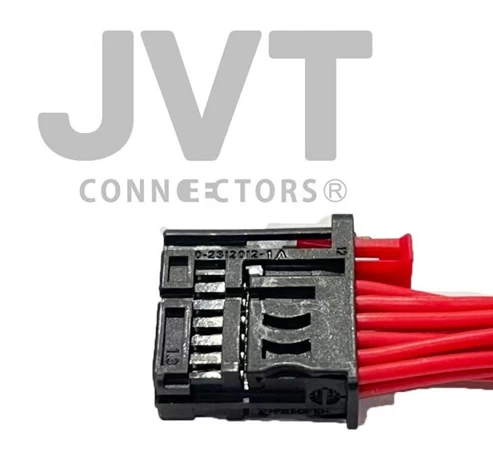I. Overview of Core Product Information
The JVT1804 series connector from JVT CONNECTORS is an automotive-grade solution designed for high-density and miniaturized connection requirements. The part number JVT1804W4T-2*07SNBKR-S-A-N13-14, a typical model of this series, has a clear structural and performance positioning. It adopts a Wire-to-Board connection format, featuring 14 contact positions arranged in 2 rows with a pin pitch of 1.8mm. As a miniaturized derivative upgraded from the mature MQS connector system, this connector integrates JVT's technical accumulation in the automotive interconnection field. It maintains industrial-grade robustness while achieving significant reductions in space and weight through structural optimization. Compatible with wire gauges ranging from 0.13mm² to 0.35mm², the signal terminal has a maximum current-carrying capacity of 6 amps and a maximum operating temperature of 170°C (for the silver-plated version), fully complying with stringent industry standards such as automotive OEM requirements and LV214.
II. Core Application Fields and Scene Adaptation
Based on the dual characteristics of "miniaturization + high reliability", the JVT1804W4T-2*07SNBKR-S-A-N13-14 connector mainly focuses on industrial and automotive electronics fields with strict space constraints and complex environmental conditions. Typical application scenarios are divided into the following four categories:
(I) Automotive Core Control Systems
As a core application scenario for automotive-grade connectors, the JVT1804W4T-207SNBKR-S-A-N13-14 has been mass-applied in the roof console of SAIC platform models, thanks to its 170°C high-temperature resistance and anti-vibration performance. This platform requires stable transmission of multi-channel control signals under various uncertain environments. The 2-row, 14-position layout of the JVT1804W4T-207SNBKR-S-A-N13-14 enables centralized management of core signals for multiple circuits and 6 channels of monitoring signals. The 1.8mm pitch design reduces the PCB layout area inside the car from 12cm² (with the traditional 2.54mm pitch solution) to 5.8cm², a reduction of over 50%, freeing up space for integrating more emission reduction control functions in other wiring harnesses.
In the airbag control system of the BMW 3 Series, the connector's dual primary and secondary locking mechanism has passed 100,000 vibration tests and simulated collision impact verifications, achieving zero failure in connection stability at the moment of collision. This completely avoids the airbag response delay caused by occasional poor contact of traditional connectors, meeting the redundant design requirements of automotive safety systems.
(II) New Energy Vehicle Energy Storage Systems
In the new energy vehicle field, the JVT1804W4T-207SNBKR-S-A-N13-14 has become one of the designated connectors for the Battery Management System (BMS) of a BYD model. The battery pack of this model requires dense arrangement of sensing lines for 12 battery cell modules. The 14-position design of the JVT1804W4T-207SNBKR-S-A-N13-14 perfectly matches the transmission needs of 10 channels of voltage collection signals and 4 channels of temperature monitoring signals (2 of which are redundant designs). The Wire-to-Board connection format increases the docking efficiency between the BMS PCB and battery cell modules by 30%.
Combined with the 0.19mm² multi-win composite wire solution developed by JVT in conjunction with the main engine manufacturer, compared with the traditional 0.25mm² copper wire solution, the weight of the BMS wiring harness per vehicle is reduced by 1.2kg, and line loss is reduced by 15%. Against the backdrop of persistently high copper prices, this helps BYD reduce the cost of the BMS connection system per vehicle by 8%. For the closed environment of the battery pack, its anti-collision design reduces the terminal damage rate during assembly from 1.2% (with traditional connectors) to 0.1%, significantly improving the production yield of battery packs.
(III) Onboard Intelligent Electronic Modules
Driven by the intelligent upgrading of automobiles, the JVT1804W4T-207SNBKR-S-A-N13-14 has been successfully introduced into SAIC's intelligent cockpit domain controller module. This module integrates multiple functions such as in-vehicle infotainment and driving assistance control, with an internal space only 60% that of traditional controllers. The small size of the JVT1804W4T-207SNBKR-S-A-N13-14 allows it to be easily embedded inside the module. Its 14 contact positions simultaneously meet the integrated transmission needs of 4 channels of high-definition camera signals, 6 channels of control commands, and 4 channels of power supply lines (adopting a separate layout for signals and power supply).
The surface-mount version of this connector, with clear docking feedback, has passed lead-free reflow soldering process verification and achieves perfect compatibility with TI's automotive-grade MCUs, earning high recognition from SAIC's R&D team for its adaptability.
(IV) Industrial and Special Electronic Equipment
Beyond the automotive field, the high robustness of the JVT1804W4T-2*07SNBKR-S-A-N13-14 also makes it suitable for certain industrial control scenarios, such as small PLCs (Programmable Logic Controllers) and industrial sensor nodes. In such scenarios, equipment often faces environmental challenges such as vibration and temperature fluctuations. The mechanical performance of the connector, which complies with the LV214 standard, ensures connection stability. The high-density layout with 1.8mm pitch can reduce the volume of industrial control boxes, adapting to the compact installation requirements of automated production lines.
In some auxiliary equipment, its space-saving advantage is also reflected, and it can be used in scenarios with strict volume restrictions such as black box data recording equipment.

III. Product Market Positioning
The market positioning of the JVT1804W4T-2*07SNBKR-S-A-N13-14 connector focuses on being a "miniaturization connection expert in the mid-to-high-end automotive electronics and industrial control fields". It accurately fills the niche market gap between conventional connectors and micro connectors, forming a clear competitive boundary and value proposition:
1.Price Dimension: Relying on JVT's brand technical premium and automotive-grade reliability, the product is positioned in the mid-to-high-end market. Its price range is higher than that of ordinary consumer electronics connectors (such as the PH series) but lower than that of military-grade micro connectors (such as the Micro-D series). It meets the core demand for "balance between performance and cost" of main engine manufacturers, Tier 1 suppliers, and industrial equipment manufacturers—satisfying the stringent standards of automotive electronics and other scenarios while avoiding cost waste caused by over-design.
2.Target Customer Group: The core service objects are global mainstream automotive OEMs (such as Volkswagen, BMW, Toyota, etc.) and their supporting electronic component suppliers, as well as new energy storage system manufacturers and industrial automation equipment enterprises (such as the small control module business lines under Siemens and Schneider). Targeting the characteristics of these customers—bulk purchasing, high reliability requirements, and long-term cooperation—the 1804 series adopts a combined model of standardized products + customized services to strengthen deep binding with customers.
3.Competitive Differentiation: Its market positioning avoids the "price war" of ordinary connectors, taking "MQS ecosystem compatibility + 1.8mm high density + automotive-grade certification" as the core differentiators to distinguish itself from similar competitors. For example, in the ECU connector bidding of a German main engine manufacturer, competing against Amphenol's Mini CT series and Molex's Pico-EZmate series, the JVT1804W4T-2*07SNBKR-S-A-N13-14 successfully won the bid by virtue of the advantage of reusing the customer's existing MQS toolchain, reducing the customer's import cost by 300,000 yuan.Meanwhile, its 14-position, 2-row layout has stronger compatibility than Amphenol Mini CT's 12-position layout, adapting to the signal transmission needs of the host factory's ECU for newly added emission monitoring functions. Compared with Molex Pico-EZmate, its 170°C high-temperature resistance is more capable of meeting the harsh environmental requirements of the engine compartment. These differentiators have enabled its market share in the mid-to-high-end automotive electronics connection market to continuously increase.

IV. Core Competitive Advantages of the Product
The competitive advantages of the JVT1804W4T-2*07SNBKR-S-A-N13-14 connector stem from JVT's design philosophy of "miniaturization without sacrificing performance", which can be elaborated from three dimensions: space optimization, reliability, and manufacturing adaptability.
(I) Extreme Space Optimization, Empowering High-Density Design
This is the most core embodiment of the product's advantages. By adopting a nominal pin pitch of 1.8mm and a miniaturized terminal size of 0.5mm × 0.4mm, the JVT1804W4T-2*07SNBKR-S-A-N13-14 reduces the PCB occupied space by up to 50% compared with traditional 2.54mm pitch connectors, while realizing integrated transmission of 14-channel signals.
This optimization not only directly reduces the volume of terminal equipment but also enables multi-module integration—for example, in automotive ECUs, signal lines for multiple functions such as engine control and emission monitoring can be integrated simultaneously, improving system integration. In addition, the weight reduction brought by the miniaturized design indirectly helps reduce energy consumption in scenarios such as new energy vehicles, complying with the industry trend of lightweighting.
(II) Multiple Safety Designs, Ensuring Reliability in Extreme Environments
As an automotive-grade connector, the JVT1804W4T-2*07SNBKR-S-A-N13-14 has formed multiple guarantees in reliability design:
- Dual Locking Mechanism: It adopts a dual primary and secondary locking mechanism. After the terminal is fully inserted, the docking status is confirmed through mechanical locking and sound feedback, avoiding the risk of poor contact. Meanwhile, an optional Connector Position Assurance (CPA) device can be configured to further enhance connection stability.
- Anti-Collision Design: This design can effectively avoid terminal damage during plugging and unplugging, improving assembly yield.
Extreme Environment Adaptability: It has a wide operating temperature range (-40°C to 170°C) and excellent anti-vibration performance, capable of withstanding extreme environments such as high temperatures in the engine compartment and bumpy road conditions, meeting the stringent stability requirements of automotive electronics.In terms of electrical performance, the 6-amp current-carrying capacity is sufficient to meet the needs of most in-vehicle signals and low-power power supply, while the silver-plated terminals further improve conductivity and corrosion resistance.
V. Summary and Application OutlookThe JVT 1.8 series JVT1804W4T-2*07SNBKR-S-A-N13-14 connector features "high density, high reliability, and high adaptability" as its core characteristics. Through its 1.8mm pitch miniaturized design, dual-locking safety mechanism, and MQS series ecosystem compatibility, it accurately matches the connection needs for "small size + strong performance" in fields such as automotive electronics and new energy storage. Its 50% space-saving capability and automotive-grade reliability give it an irreplaceable competitive advantage in scenarios such as intelligent vehicles and industrial control.
In the future, with the further deepening of automotive electrification and intelligence, as well as the continuation of the miniaturization trend of industrial equipment, the application scenarios of miniaturized connectors such as the JVT1804W4T-2*07SNBKR-S-A-N13-14 will continue to expand. In emerging fields such as automotive lidar, battery module sub-units, and small industrial sensors, its space and reliability advantages will be more fully exerted. For enterprises, this connector is not only a choice of connection components but also an important support for enhancing the competitiveness of terminal products.

